Kumusta, Business People! Are you here because of noticing your inventory records are often errors and causing trouble, such as overstocking or understocking? Fortunately, physical inventory counts offer a reliable solution to this problem.
A physical inventory count gives you a clear and accurate picture of your stock, thus reducing storage costs which can be as much as 30-60% of the inventory value itself. By carefully tracking each item, you can avoid mistakes and save money.
But, what is physical inventory? Is it necessary to implement it nowadays in the Philippines? Pag-usapan natin ito nang magkasama!
Key Takeaways
|
Table of Content
Content Lists

What is Physical Inventory?
Physical inventory is the process of manually counting all items in a store or warehouse to verify the accuracy of stock records. This crucial audit helps identify discrepancies between recorded data and actual stock, preventing losses and ensuring effective inventory management.
The physical count process starts by counting all items from the sales floor to the backroom and comparing these counts with your POS system records to correct discrepancies. It includes all product types, ensuring your actual stock matches the recorded figures accurately.
Benefits of Physical Inventory Count
Regular physical inventory counts are vital for maintaining control over your stock. Hay naku! This process can give you countless benefits, but to start, let’s take a look at some of its down below.
- Inventory accuracy: Regular counts ensure that the actual stock matches the recorded figures, which is essential for detecting issues like inventory loss or misshipments.
- Demand forecasting: Accurate inventory data helps in predicting future product needs more accurately, which aids in better stock management and increased profitability.
- Prevention of stockouts: Keeping an accurate physical count helps avoid situations where products are out of stock, thereby enhancing customer satisfaction and reducing lost sales.
- Management of slow-moving items: Identifying and addressing slow-moving inventory can help in taking necessary actions like promotions or discounts to move the stock and free up space for new products.
- Reduction in inventory shrinkage: Regular inventory checks help in the early detection of discrepancies due to theft or errors, enabling timely corrective measures.
- Optimal stock levels: By regularly updating inventory records, businesses can avoid over- or under-stocking, both of which can negatively impact the financial health of the business.
Types of Physical Inventory
 As an ideal entrepreneur, of course, you don’t want to ruin your business by choosing the wrong type of physical inventory, diba? Therefore, there are 4 types of physical count of inventory you should know about in the Philippines, such as:
As an ideal entrepreneur, of course, you don’t want to ruin your business by choosing the wrong type of physical inventory, diba? Therefore, there are 4 types of physical count of inventory you should know about in the Philippines, such as:
- Manual counting: Employees count items by hand, a cost-effective method but prone to human error.
- Electronic counting: Utilizes barcode scanners and POS systems for faster and more accurate counting.
- Cycle counting: This involves counting a portion of the inventory at regular intervals instead of a full inventory count, which can save time and reduce disruptions.
- Full inventory count: Usually conducted annually, this inventory count procedures approach involves counting all inventory items, crucial for accurate year-end financial reporting.
When to Conduct a Physical Inventory Count
Deciding when to conduct a physical inventory count involves considering several factors that can significantly impact the effectiveness of the process. These factors include the number of items managed (SKUs), daily sales, and whether the business uses technology like POS systems or barcode scanners.
Businesses with a high number of SKUs or high sales volume might require more frequent counts to ensure accuracy and control. Using advanced technological tools can also influence the frequency, as systems like barcode scanners can streamline the counting process.
Regular physical inventory counts are critical for maintaining accurate financial records and preventing stockouts. Many businesses conduct physical inventory counts at least once a year, but some may need to do them more often based on their specific operational needs and how quickly their inventory changes.
How to Conduct a Physical Inventory Count
 Efficiently counting your physical inventory involves several crucial steps that ensure accuracy and reliability throughout the process:
Efficiently counting your physical inventory involves several crucial steps that ensure accuracy and reliability throughout the process:
- Planning: Assign specific tasks and areas to count, ensuring that each team member understands their responsibilities. This phase may include creating a detailed timetable and a checklist of areas and items to be counted.
- Organizing: Break down the inventory count procedures into manageable sections and ensure that all items are accessible. This step can involve cleaning and organizing the warehouse or store areas to make the counting process smoother and faster.
- Counting: Choose the most suitable counting method, manual or using inventory software. Stick to it to ensure consistency of business processes. Tiyaking piliin ang pinakamahusay na inventory system kailanman.
- Reconciling: Investigate any discrepancies you find using inventory reconciliation to understand their causes—whether they are due to errors in counting, problems in data entry, or issues of theft and loss.
- Updating records: Finally, update your inventory management system with the accurate counts from your physical count of inventory. This ensures that your records are up-to-date and reflect the true state of your stock, providing reliable information for making business decisions.
If you truly want to optimize your inventory management and experience the full benefits of streamlined inventory processes, why you don’t take advantage of a free demo? By using a free demo, you can see how this system can transform your business into an error-free operation.
Challenges in Physical Inventory
While physical inventory counts are crucial, they can present several challenges for companies. Here are some common issues that businesses may encounter during the process:
1. Time and Resource Constraints
One of the biggest challenges companies face with physical inventories is the required time and resources. Many businesses find it necessary to shut down parts or even all operations to conduct a thorough inventory. This disruption can lead to poor customer service, as operations are paused during the count.
2. Limited Staff Availability
Not all companies have enough staff to complete a full physical inventory. Smaller businesses, in particular, may struggle with the manpower needed to accurately count all inventory items, making the process even more challenging.
3. Common Discrepancies in Physical Counts
Discrepancies during physical inventory counts often arise due to inaccurate recording by internal or temporary staff. Common issues include:
- Incorrect recording: Some inventory items may be inaccurately documented or incorrectly classified, leading to mismatches in inventory records.
- New Item errors: New inventory items might be recorded improperly, further complicating the count’s accuracy.
4. Items to exclude from physical inventory
Regardless of how accurate the inventory count procedures is, certain items should be excluded from the count:
- Supplier receipts: Any supplier receipts that arrived after the predetermined cut-off date should not be included in the count.
- Known thefts: Items that have been identified as stolen should not be counted in the inventory.
- Uninvoiced shipments: Any shipments that have departed but do not have accompanying invoices should also be excluded from the physical inventory.
That being said, inventory counts should be done carefully, so that the whole inventory control processes can go as smoothly as possible.
Tips and Best Practices for Physical Inventory Count
 Conducting a physical inventory count is essential for maintaining accurate stock records. Here are five key tips and best practices to ensure your inventory counts are effective and efficient:
Conducting a physical inventory count is essential for maintaining accurate stock records. Here are five key tips and best practices to ensure your inventory counts are effective and efficient:
- Prepare thoroughly: Clean and organize your storage areas before the count to ensure all items are easily accessible. This preparation reduces time spent searching and sorting during the count.
- Equip and train: Provide your team with the necessary tools such as scanners and cloud inventory software. Additionally, train all participants on the counting procedures and the importance of accuracy to minimize errors.
- Schedule strategically: Conduct the inventory during low-activity periods, such as after business hours or during slower seasons, to minimize disruptions and maintain focus on accuracy.
- Divide and conquer: Break down the inventory into manageable sections and assign teams to different areas based on their knowledge and experience with the products. This targeted approach helps in conducting thorough and efficient counts.
- Review and analyze: After completing the count, review the results for discrepancies and investigate the causes. Use these insights to improve your inventory management practices and procedures for future counts.
Streamlining Inventory Physical Counts with HashMicro
 HashMicro’s inventory management software is a go-to solution for businesses to make their inventory counts for inventory more effective. Helped more than 1750 clients all over Southeast Asia, this physical inventory vendor offers a comprehensive system with complete features.
HashMicro’s inventory management software is a go-to solution for businesses to make their inventory counts for inventory more effective. Helped more than 1750 clients all over Southeast Asia, this physical inventory vendor offers a comprehensive system with complete features.
Not only that, the HashMicro also offers you a free demo starting today. By these free trials, you can know the performance of the system better. Business people, curious ka ba sa mga feature na inaalok sa iyo ng HashMicro? Here is the list:
- RFID warehouse racks stock in out automation: Automate the tracking of inbound and outbound movement of stock on warehouse shelves, improving efficiency and accuracy.
- Stock forecasting: A system that analyzes historical sales data, seasonal trends, and other factors to predict future demand for goods.
- Stock optimizer per warehouse: The system provides information about the health status of warehouse occupancy to optimize rack storage capacity by providing a strategy for placing goods between warehouses.
- Fast and slow-moving stocks analysis: Analyze historical data related to stock items in the warehouse to identify fast-moving and slow-moving items in the inventory.
After knowing this, you may know that the inventory management software Philippines from HashMicro can help you to automate prompts for what needs counting and improve quality assurance—all leading to happier customers. Plus, as you cycle count, discrepancies get smaller and smaller, making reconciliation a breeze.
Conclusion
Efficient physical inventory counting is crucial for maintaining accurate stock levels and ensuring the smooth operation of any business. These practices not only prevent errors and losses but also provide vital data for making informed business decisions.
To see how this technology can streamline the inventory process, start by signing up for a free demo of HashMicro’s inventory management system. This will give you access to advanced tools that enhance the way you count and manage stock. Makikita mo kung gaano kadali ang pamamahala ng imbentaryo.

FAQ About Physical Inventory
-
What is a physical inventory usually taken?
A physical inventory is usually performed when only a small number of goods are being sold or received; moreover, it is also conducted at the end of the company’s fiscal year.
-
What are the characteristics of physical inventory?
Physical inventory counts typically include raw materials, works-in-process (WIP), finished goods, as well as packing materials, maintenance, repair, and operations (MRO) supplies.
-
What involves physical inventory?
Physical inventory involves tracking the sellable goods currently in stock, measured by weight, volume, or units. By managing items at the SKU level, businesses can ensure consistency between physical counts and inventory records.
{
“@context”: “https://schema.org”,
“@type”: “FAQPage”,
“mainEntity”: [{
“@type”: “Question”,
“name”: “What is a physical inventory usually taken?”,
“acceptedAnswer”: {
“@type”: “Answer”,
“text”: “A physical inventory is usually performed when only a small number of goods are being sold or received; moreover, it is also conducted at the end of the company’s fiscal year.”
}
},{
“@type”: “Question”,
“name”: “What are the characteristics of physical inventory?”,
“acceptedAnswer”: {
“@type”: “Answer”,
“text”: “Physical inventory counts typically include raw materials, works-in-process (WIP), finished goods, as well as packing materials, maintenance, repair, and operations (MRO) supplies.”
}
},{
“@type”: “Question”,
“name”: “What involves physical inventory?”,
“acceptedAnswer”: {
“@type”: “Answer”,
“text”: “Physical inventory involves tracking the sellable goods currently in stock, measured by weight, volume, or units. By managing items at the SKU level, businesses can ensure consistency between physical counts and inventory records.”
}
}]
}



































